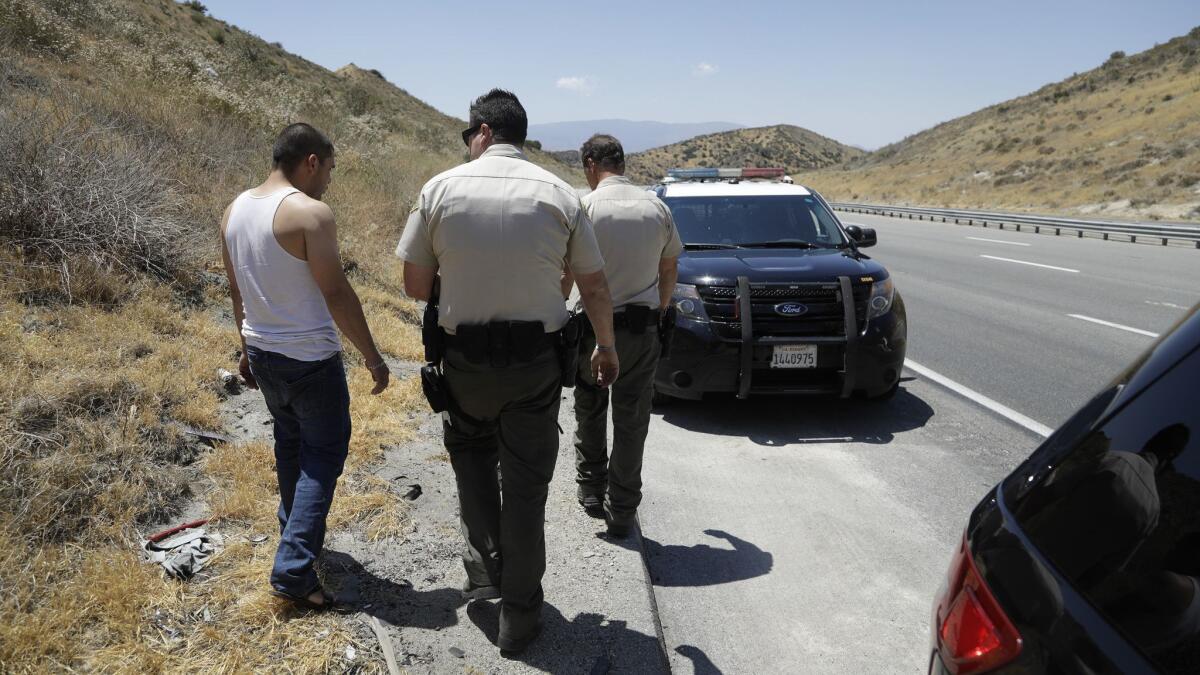Sheriff’s Department ‘ignored red flags’ about team that stopped Latino drivers, report says

- Share via
A Los Angeles County Sheriff’s Department team that pulled over thousands of motorists on the 5 Freeway in search of drugs “had a constitutionally troubling impact on Latino drivers,” the county inspector general’s office concluded in a widely anticipated report.
In a rebuke of the Sheriff’s Department released Friday, the county Office of Inspector General said that not only were Latinos targeted at a much higher rate, but that the effectiveness of the sheriff’s special team — which was created to stop the flow of drugs in the Santa Clarita Valley area — was unclear.
Moreover, the report said, the effect on Latinos has “the potential to negatively impact the public’s trust” in the Sheriff’s Department.
It faulted sheriff’s officials for failing to provide proper oversight, allowing the team to “operate unchecked” until it was suspended on Nov. 16, a day after County Inspector General Max Huntsman verbally called it “inherently built to violate the constitutional rights of a vast number of people passing through the I-5 Freeway.”
“Latinos were both stopped and searched at much greater rates than other racial or ethnic groups, and yet, there was a very low rate of success in finding contraband” — less than 2%, the report said of the Santa Clarita Valley Domestic Highway Enforcement Team. The unit focused on Interstate 5 between the Kern County line and Highway 14.
Furthermore, the inspector general’s office said, “the rate of successful arrests and prosecutions of those stopped and searched by the [team] was low.”
The report echoes a Times investigation published in October that found more than two-thirds of drivers pulled over by the sheriff’s special team were Latino, and that the searches of vehicles of more than 3,500 drivers turned up no drugs or other illegal items.
The report also details an array of problems in the prosecutions of those arrested — so much that nearly a third of federal criminal filings, 11 of 36, were dismissed by the courts or by prosecutors. In two cases, a factor was a deputy’s history of being investigated for lying to federal prosecutors about properly obtaining consent to search a vehicle.
Eventually, the Sheriff’s Department stopped referring criminal cases to the U.S. attorney’s office and focused on filing cases to county prosecutors.
The inspector general’s office said the Sheriff’s Department should have been aware of problems with its team. As early as 2014, the report said, the U.S. attorney’s office told sheriff’s officials of credibility problems regarding a deputy assigned to this team; yet no study was done to determine whether there were systemic issues behind the team’s practices.
“The department ignored red flags about the [team’s] practices and one of the team member’s credibility. Had the department monitored the case dispositions after they were presented to the [U.S. attorney’s office], it would have seen that problems were present,” the report said.
The inspector general’s office said there were problems with oversight of the team as soon as it was created in 2012. The team — made up of a sergeant, four deputies, a part-time narcotics detective and a drug-sniffing dog — focused on the Grapevine section of Interstate 5, between the northern border of L.A. County to Santa Clarita.
It was launched as members of communities along the freeway asked what authorities were doing to stop the flow of drugs, and as sheriff’s officials explored whether the Grapevine section of Interstate 5 was used to move drugs from the Mexican border while cash and guns moved south.
The Sheriff’s Department never developed or implemented a captain’s proposal to demonstrate that deputies were not racially profiling motorists, the report said.
The inspector general’s office reviewed nearly 1,000 traffic stops conducted by the team between April 2018 and September 2018 and found:
- 68% of the occupants of the vehicles stopped were Latino;
- Out of more than 300 searches that resulted from drivers giving their consent, 82% were of vehicles occupied by Latinos;
- Of about 250 people who were detained in the back seat of a patrol vehicle, 88% were Latino;
- Of nearly 450 pulled over for at least 10 minutes and let off with a warning, 74% were Latino. Of those Latinos, one-quarter were held for more than one hour.
The report said just 26 stops — 2.7% of the total — resulted in arrests, and only 21 stops, or 2.1%, resulted in drug-related arrests.
In contrast, the California Highway Patrol offered different racial data. Latinos made up 43% of motorists who were issued citations.
The inspector general’s office criticized the method by which supervisors of the sheriff’s team articulated how they identified who they would pull over. Managers said the team used not racial profiling, but “criminal profiling,” generally referring to criteria suggesting that a violation of law may be occurring.
That criteria included such factors as driving a car that needed repairs, driving an expensive car, acting too calmly, acting too nervously, having a car filled with air fresheners, driving a rental car or driving with an out-of-state license plate. Deputies would then look for traffic violations that legally justified a stop and looked for hints of drugs, such as signs of stress or deception by the driver, the report said.
One deputy told the inspector general’s office that he developed a criminal profile of drivers and passengers based on their body language as he passed their vehicle, then ran the license plate randomly for “suspicious” signs such as: Is the vehicle a rental car from San Diego or a northern city such as Stockton; is the car title a salvaged title; does the car have new plates on an old car?
He also said he looked for signs of drivers not acting like “normal” commuters; he described normal commuters as ones who make eye contact and drive without making suspicious moves.
“The factors that inform the [team’s] criminal profiling include criteria that may not explicitly touch on racial or ethnic identity, but which may unintentionally contribute to a disproportionate number of stops of members of specific racial or ethnic communities,” the report said.
The factors indicated by sheriff’s officials are so broad that “many, if not most, motorists exhibit while driving,” the report said. “Without strict and clear guidance from department policy and sufficient training against racial profiling and on implicit bias, this discretion could lead [team] deputies to target Latino motorists.”
The inspector general’s office said it did not observe verbalized indications of discriminatory enforcement based on race or ethnicity when staffers participated in 16 hours of ride-alongs, but the report did note that 11 of the 12 drivers pulled over were Latino. Among the stated reasons for stops were tinted windows, broken taillights and body language. One was arrested after $140,000 was found in a backpack, the other 11 were let go with warnings.
The report found that Latinos had the highest chance of being asked by a deputy to authorize a search. Of more than 300 so-called consent searches, 82% of them were on vehicles driven by a Latino driver — more than 7 times greater than that of vehicles driven by whites. Illegal items were found in just 6% of the searches.
That data suggest that “deputies may have been asking for consent to search vehicles without having adequate reasonable suspicion that the motorist possessed contraband. If they did have satisfactory reasonable suspicion, we would expect the rate of seizures per consent searches to be greater than what the data shows,” the report said.
The Sheriff’s Department should have been on notice about minorities being disproportionately affected by traffic stops, the report said, given federal scrutiny into agency practices in nearby Antelope Valley. In 2011, the U.S. Department of Justice civil rights division expanded an investigation into allegations that employees assigned to the Sheriff Department’s Lancaster and Palmdale stations engaged in a pattern or practice of racially motivated stops and arrests.
“It is critical that law enforcement agencies act in a constitutional manner to ensure, at minimum, that the community has confidence in the agencies empowered to enforce the law,” the report said.
This L.A. sheriff’s deputy was a pariah in federal court. But his secrets were safe with the state »
[email protected] | Twitter: @ronlin
[email protected] | Twitter: @bposton
More to Read
Sign up for Essential California
The most important California stories and recommendations in your inbox every morning.
You may occasionally receive promotional content from the Los Angeles Times.












